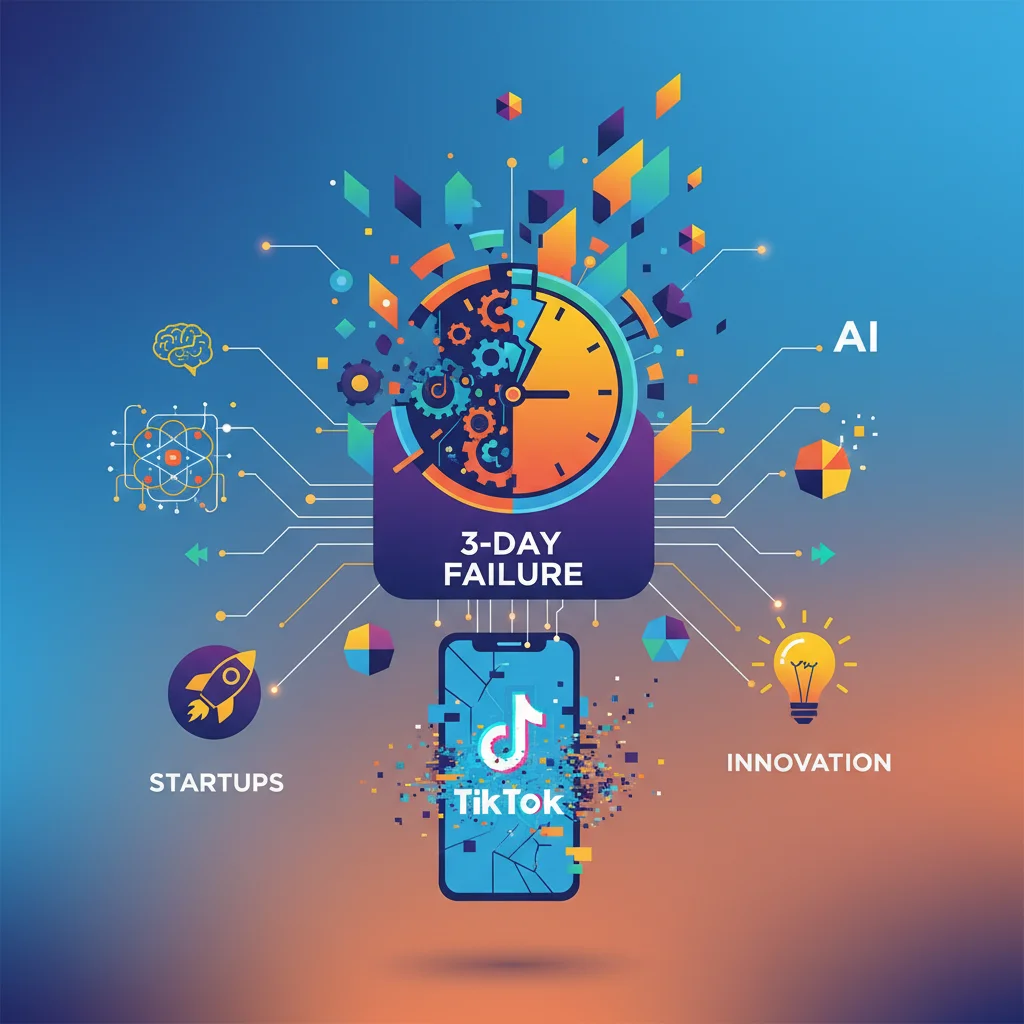
Anatomy of a Catastrophe: What Sky Sports’ 3-Day TikTok Failure Teaches Us About AI, Startups, and Innovation
Anatomy of a Catastrophe: What Sky Sports’ 3-Day TikTok Failure Teaches Us About AI, Startups, and Innovation
In the fast-paced world of digital media, failure often comes swiftly. But rarely is it as spectacular, public, and immediate as the recent implosion of Sky Sports’ “Halo” TikTok channel. Launched with the goal of engaging a female audience, the channel was shut down in just three days after a torrent of criticism labeled it “patronising” and “sexist.” According to the BBC, the content, which included clips of male presenters discussing “first dates” and the “icks” women get from men, missed the mark so profoundly that the media giant was forced into a full retreat.
On the surface, this is a story about a marketing misstep—a legacy brand failing to understand a modern platform and its audience. But dig a little deeper, and it becomes a powerful case study for everyone in the tech ecosystem, from developers and entrepreneurs to startup founders and innovation leaders. This wasn’t just a creative failure; it was a catastrophic failure of data, strategy, and imagination. It’s a glaring example of what happens when you substitute outdated stereotypes for genuine, data-driven audience understanding—a problem that modern technology, particularly artificial intelligence and machine learning, is uniquely positioned to solve.
How could a media powerhouse with immense resources get it so wrong? And more importantly, what lessons can we extract from this public faceplant to build better products, smarter software, and more resilient companies?
The Anatomy of a Digital Faceplant
To understand the solution, we must first dissect the problem. The “Halo” channel was designed to broaden Sky Sports’ appeal, a laudable goal for any brand looking to grow. The execution, however, was a masterclass in what not to do. Instead of creating content that celebrated women in sports, highlighted female athletes, or offered insightful commentary from a fresh perspective, the channel leaned into tired tropes about dating and relationships.
The backlash was instant. Social media users pointed out the condescending tone and the bizarre assumption that the only way to talk to women about sports was to filter it through a lens of romantic clichés. It was a classic case of a team in a boardroom making assumptions about a demographic they clearly didn’t understand. They built a product based on a caricature, and the intended audience rejected it forcefully.
This is a familiar pattern, not just in media, but in the world of startups and software development. A team has an idea, falls in love with its own assumptions, and pushes forward without adequate validation. The result is a product that solves a problem nobody has or, in this case, serves an audience in a way they find offensive. In an era of powerful analytical tools, this kind of guesswork is not only lazy—it’s unforgivably expensive.
The Trojan Bus: Can Your City Be Switched Off From Halfway Across the World?
The AI-Powered Alternative: From Guesswork to Intelligence
Imagine a different timeline. Before launching “Halo,” the Sky Sports team leverages a modern tech stack to inform their strategy. Instead of relying on gut feelings and stereotypes, they deploy sophisticated tools to build a data-centric plan. What would that look like?
1. AI-Powered Sentiment Analysis and Audience Intelligence
First, they would use AI and machine learning algorithms to analyze millions of public data points from TikTok, Twitter, Instagram, and sports forums. These tools can go far beyond simple keyword tracking. They can identify nuanced topics, gauge sentiment, and pinpoint the specific conversations female sports fans are *actually* having. An AI model could have quickly revealed that these conversations are about performance analytics, team strategies, fantasy leagues, and celebrating athletic achievement—not “first date icks.” This data, often delivered via a user-friendly SaaS dashboard, provides a real-time, unbiased view of the target audience’s true interests.
2. Machine Learning for Hyper-Personalization
Armed with this intelligence, the next step would be content strategy. Instead of a one-size-fits-all, patronizing approach, they could use machine learning models to segment the audience. The “female sports fan” is not a monolith. She could be a data-obsessed fantasy football manager, a passionate supporter of a local women’s team, an admirer of a specific athlete’s training regimen, or someone who enjoys the social aspect of the game. A personalized content strategy, driven by automation, could deliver different types of content to different segments, dramatically increasing engagement and avoiding the alienation that “Halo” caused.
3. Agile Development and A/B Testing
The world of programming and modern software development abandoned the “waterfall” method (build everything, then launch) years ago in favor of agile methodologies. The same principle applies to content. Instead of launching a fully-formed channel based on a flawed premise, an agile approach would involve testing small content hypotheses. They could have run a dozen different “dark posts” (ads visible only to a specific target audience) on TikTok, each with a different angle. Data on which posts received the best engagement would have provided invaluable, real-world feedback, allowing them to pivot their strategy before a single public video was ever posted. This iterative process, powered by cloud infrastructure, de-risks innovation and prevents catastrophic launch failures.
To crystallize this difference, let’s compare the two approaches:
| Strategic Pillar | Legacy “Halo” Approach (Stereotype-Driven) | Modern Tech Approach (AI-Driven) |
|---|---|---|
| Audience Research | Internal brainstorming, outdated assumptions, broad demographic stereotypes. | AI-powered sentiment analysis, social listening, analysis of real-time conversations. |
| Content Strategy | One-size-fits-all, based on patronizing clichés about what women want. | Hyper-personalized, with content tailored to specific audience segments identified by machine learning. |
| Launch Process | “Big Bang” launch of a fully-formed channel, high-risk and high-impact. | Agile, iterative testing of multiple content concepts via dark posts to validate ideas with real data. |
| Key Technology | Standard video production and social media scheduling tools. | Cloud-based SaaS platforms, AI/ML for analytics, automation for content delivery and testing. |
Actionable Lessons for Startups, Developers, and Innovators
The Sky Sports “Halo” saga is more than just a cautionary tale for big media. It offers critical, actionable insights for anyone involved in building and launching new products or services in the tech world.
1. Your Assumptions Are Not a Business Plan
Every startup begins with an assumption. The danger lies in not rigorously testing it. “Halo” was built on the assumption that women needed sports “dumbed down.” This was never validated. For entrepreneurs, the takeaway is clear: use the vast array of SaaS tools available—from survey platforms to A/B testing frameworks—to get real-world feedback before you write a single line of production code. The “Lean Startup” methodology is more relevant than ever. Validate, iterate, or pivot. Don’t build an entire product on a hunch.
The AI Gold Rush: How to Find Gold Without Getting Caught in the Bubble
2. Embrace Reputational Cybersecurity
In today’s hyper-connected world, a brand’s reputation is one of its most valuable assets. We typically think of cybersecurity in terms of protecting data from hackers. But a PR disaster like “Halo,” which can wipe out brand equity overnight, is a threat of a similar magnitude. Modern cybersecurity is expanding to include brand safety. This involves using AI-powered monitoring tools to track brand sentiment in real-time, providing an early warning system for potential backlash. For developers, this means building systems with brand safety in mind. For startups, it means investing in tools that protect your reputation with the same vigor you protect your servers.
3. Program for People, Not Demographics
The core failure of “Halo” was treating its audience as a monolithic demographic rather than a diverse group of individuals. The best programming and product design comes from a deep, empathetic understanding of the end-user. This is the essence of UX/UI design, but it extends to the entire product lifecycle. Are you building your software based on a stereotype, or have you conducted deep user interviews? Is your AI’s personalization engine genuinely helpful, or is it making creepy or incorrect assumptions? The most successful technology feels human because it was designed with a profound respect for the humans who will use it.
Conclusion: The Future is Authentic
The swift and brutal demise of Sky Sports’ “Halo” is a powerful reminder that in the digital age, authenticity is not a buzzword; it is the ultimate currency. Audiences, especially on platforms like TikTok, have a finely tuned radar for inauthentic, condescending, or lazy content. They will not hesitate to call it out.
For those of us in the technology and startup space, the story is a clear signal. We have an unprecedented arsenal of tools at our disposal—artificial intelligence, cloud computing, sophisticated SaaS platforms, and powerful automation engines. These tools give us the ability to understand, segment, and serve audiences with a level of precision that was unimaginable a decade ago. But they are just that: tools.
The ultimate failure of “Halo” was a human one—a failure of curiosity and respect. The greatest innovation of the next decade will not come from a single algorithm or piece of software. It will come from combining the power of this technology with genuine human empathy to build products and create experiences that are not only intelligent but also authentic, respectful, and truly valuable to the people they are meant to serve.
The AI We Have vs. The AI We Need: A Stanford Economist's Urgent Warning


